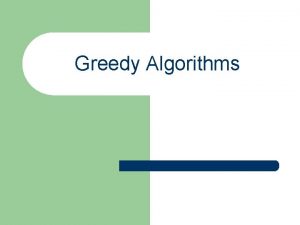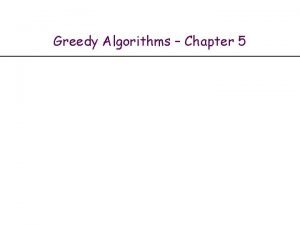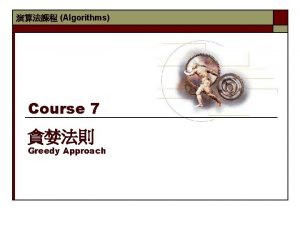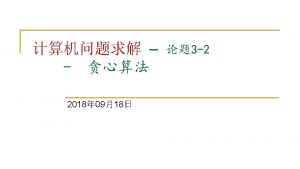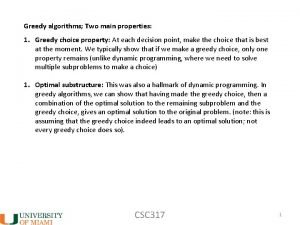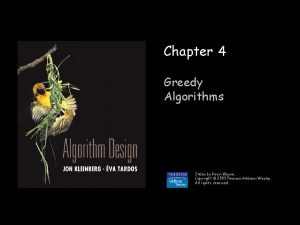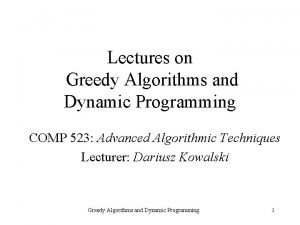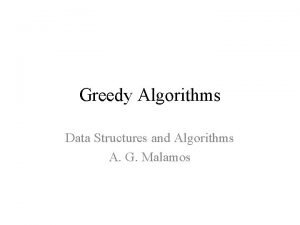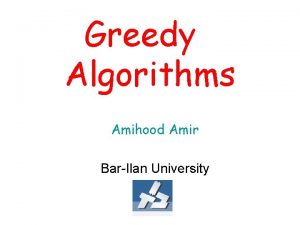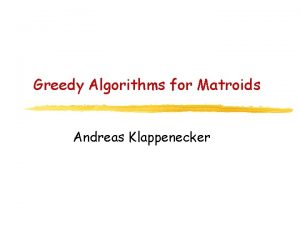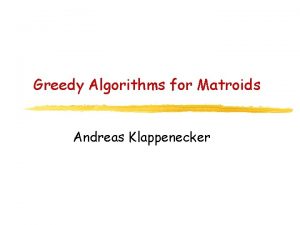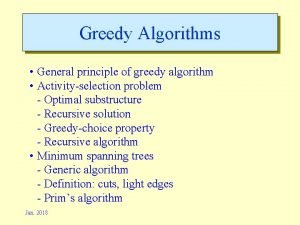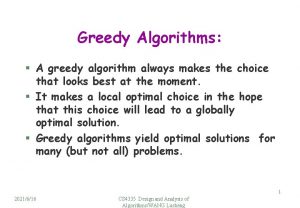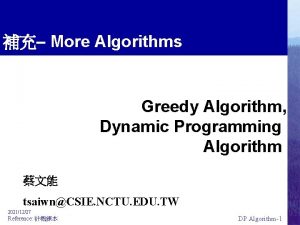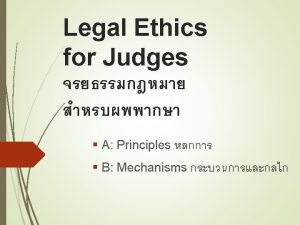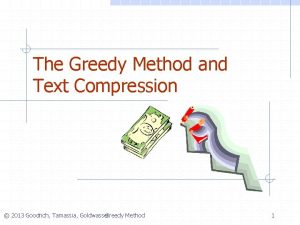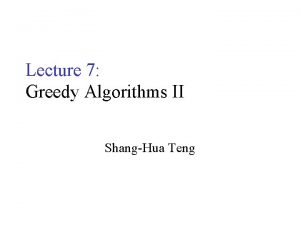Independence Systems Matroids the Greedy Algorithm and related





























- Slides: 29

Independence Systems, Matroids, the Greedy Algorithm, and related Polyhedra Martin Grötschel Summary of Chapter 4 of the class Polyhedral Combinatorics (ADM III) May 25, 2010 & June 1, 2010 Martin Grötschel § Institute of Mathematics, Technische Universität Berlin (TUB) § DFG-Research Center “Mathematics for key technologies” (MATHEON) § Konrad-Zuse-Zentrum für Informationstechnik Berlin (ZIB) groetschel@zib. de http: //www. zib. de/groetschel

Matroids and Independence Systems Let E be a finite set, I a subset of the power set of E. The pair (E, I ) is called independence system on E if the following axioms are satisfied: (I. 1) The empty set is in I. (I. 2) If J is in I and I is a subset of J then I belongs to I. Let (E, I ) satisfy in addition: (I. 3) If I and J are in I and if J is larger than I then there is an element j in J, j not in I, such that the union of I and j is in I. Then M=(E, I ) is called a matroid.

Notation Let (E, I ) be an independence system. § Every set in I is called independent. § Every subset of E not in I is called dependent. § For every subset F of E, a basis of F is a subset of F that is independent and maximal with respect to this property. § The rank r(F) of a subset F of E is the cardinality of a largest basis of F. Important property, submodularity: § The lower rank basis of F is the cardinality of a smallest

The Largest Independent Set Problem: Let (E, I ) be an independence system with weights on the elements of E. Find an independent set of largest weight. We may assume w. l. o. g. that all weights are nonnegative (or even positive), since deleting an element with nonpositive weight from an optimum solution, will not decrease the value of the solution.

The Greedy Algorithm Let (E, I ) be an independence system with weights c(e) on the elements of E. Find an independent set of largest weight. The Greedy Algorithm: 1. Sort the elements of E such that 2. Let 3. FOR i=1 TO n DO: 4. OUTPUT A key idea is to interprete the greedy solution as the solution of a linear program.

6 The greedy algorithm works for matroids § Proof using axiom (I. 3) on the blackboard. Martin Grötschel

Polytopes and LPs Let M=(E, I ) be an independence system with weights c(e) on the elements of E.

The Dual Greedy Algorithm Let (E, I ) be an independence system with weights c(e) for all e. After sorting the elements of E so that set (integral if the weights are integral)) Then is a feasible solution of the dual LP by construction.

Observation Let (E, I ) be an independence system with weights c(e) for all e. After sorting the elements of E so that We can express every greedy and optimum solution as follows:

Rank Quotient Let (E, I ) be an independence system with weights c(e) for all e. The number q is between 0 and 1 and is called rank quotient of (E, I ). Observation: q = 1 iff (E, I ) is a matroid.

The General Greedy Quality Guarantee a quality guarantee

Consequences Let M=(E, I ) be an independence system with weights c(e) on the elements of E.

13 Consequences Theorem. For every independence system (E, I with weights c(e) for all elements e of E, max c. Tx, xϵP(I) ≥ c(Iopt) ≥ c(Igreedy) ≥ q max c. Tx, xϵP(I) ≥ q c(Iopt), in other words, the greedy solution value is bounded from below by q times the maximum value of the LP relaxation and not only by q times the optimum value of the weighted independent set problem. Martin Grötschel

14 More Proofs § Another proof of the completeness of the system of nonnegativity constraints and rank inequalities will be given in the class on the blackboard, see further slides. Martin Grötschel

15 Martin Grötschel Completeness Proof of the Matroid Polytope

16 Completeness Proof of the Matroid Polytope (continued) The proof above is from (GLS, pages 213 -214), see http: //www. zib. de/groetschel/pubnew/paper/groetschellovaszschrijver 1988. pdf Martin Grötschel

17 Facets of the matroid polytope § It will also be shown on the blackboard that a rank inequality x(F) ≤ r(F) defines a facet of the matroid polytope if and only if the set F is closed and inseparable, see Martin Grötschel, Facetten von Matroid-Polytopen, Operations Research Verfahren XXV, 1977, 306 -313, downloadable from http: //www. zib. de/groetschel/pubnew/paper/groetschel 1977 d. pdf § A subset F of E is closed if r(F U {e})>r(F) for all e in EF. Martin Grötschel § A subset F of E is separable if there exist two nonempty disjoint subsets F 1 and F 2 of F whose union is F and such that r(F)= r(F 1)+ r(F 2).

18 The Forest Polytope Martin Grötschel

19 A Partition Matroid Polytope Martin Grötschel

20 The 1 -Tree Polytope 1 -trees come up as relaxations of the symmetric travelling salesman problem. Given a complete graph Kn=(V, E), V={1, 2, …, n}. A 1 -tree is the union of the edge set of a spanning tree of the complete graph on the node set {2, 3, …, n} and two edges with endnode 1. Every 1 -tree has n edges and contains exactly one cycle. This means that every travelling salesman tour is a 1 -tree. The set of 1 -trees is the set of bases of a matroid on E. A complete description of the convex hull of the incidence vectors of all 1 -trees in Kn is given by: 0≤ xe ≤ 1 for all e in E x(E(W)) ≤ |W| - 1 for all node sets W in V not containing 1 x(δ(1)) = 2 x(E) = n Martin Grötschel

21 Martin Grötschel The Branching and the Arborescence Polytope

22 Martin Grötschel The Branching and the Arborescence Polytope

23 The Matroid Intersection Polytope Martin Grötschel

24 The Matroid Intersection Polytope Martin Grötschel

25 The Matroid Intersection Polytope Martin Grötschel

26 The Matroid Intersection Polytope Martin Grötschel The proof above is from (GLS, pages 214 -216), see http: //www. zib. de/groetschel/pubnew/paper/groetschellovaszschrijver 1988. pdf

27 Submodular Functions and Polymatroids § The whole polyhedral and algorithmic theory developed so far can be generalized to submodular functions and polymatroids. § This is worked out in detail in Chapter 10 of (GLS), see http: //www. zib. de/groetschel/pubnew/paper/groetschellovaszschrijver 1988. pdf Martin Grötschel

28 Claude Berge (perfect graphs) and Jack Edmonds (matching and matroids) Martin Grötschel

Independence Systems, Matroids, the Greedy Algorithm and related Polyhedra Martin Grötschel The End Summary of Chapter 4 of the class Polyhedral Combinatorics (ADM III) May 18, 2010 Martin Grötschel § Institute of Mathematics, Technische Universität Berlin (TUB) § DFG-Research Center “Mathematics for key technologies” (MATHEON) § Konrad-Zuse-Zentrum für Informationstechnik Berlin (ZIB) groetschel@zib. de http: //www. zib. de/groetschel
 Divide and conquer and greedy method
Divide and conquer and greedy method What is greedy
What is greedy Physical fitness two types
Physical fitness two types Health-related
Health-related Greedy snake algorithm
Greedy snake algorithm Greedy method
Greedy method Greedy algorithm
Greedy algorithm Activity selection problem greedy algorithm example
Activity selection problem greedy algorithm example Activity selection problem
Activity selection problem Greedy interval partitioning
Greedy interval partitioning Fractional knapsack problem
Fractional knapsack problem Activity selection problem greedy algorithm
Activity selection problem greedy algorithm Greedy algorithm for job sequencing with deadlines
Greedy algorithm for job sequencing with deadlines Contoh knapsack problem
Contoh knapsack problem Huffman greedy algorithm
Huffman greedy algorithm Greedy algorithm vs dynamic programming
Greedy algorithm vs dynamic programming What is greedy choice property
What is greedy choice property Greedy algorithm list
Greedy algorithm list 4greedy
4greedy Coin change greedy algorithm proof
Coin change greedy algorithm proof Knapsack problem statement
Knapsack problem statement Greedy algorithm time complexity
Greedy algorithm time complexity Greedy algorithm
Greedy algorithm General principle of greedy algorithm
General principle of greedy algorithm Prefixfree
Prefixfree Greedy method in data structure
Greedy method in data structure Greedy algorithm
Greedy algorithm Pairwise exchange method
Pairwise exchange method Ao* algorithm example
Ao* algorithm example Sweep line algorithm cp algorithm
Sweep line algorithm cp algorithm

